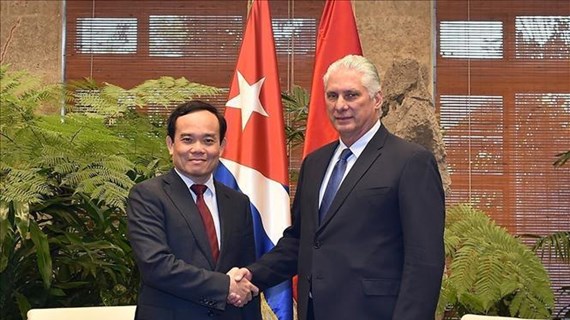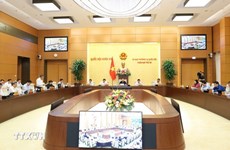Visa exemption to help Phu Quoc Island take off
A policy to grant a 30-day visa exemption for foreign passport holders
visiting Phu Quoc Island off the coast of the southern province of Kien
Giang from March 10 is expected to help transform the world-famous
tourist destination into a national and international hi-end holiday
heaven.
A policy to grant a 30-day visa exemption for foreign passport holders
visiting Phu Quoc Island off the coast of the southern province of Kien
Giang from March 10 is expected to help transform the world-famous
tourist destination into a national and international hi-end holiday
heaven.
The exemption is part of specific mechanisms and policies included in a recent decision by the Prime Minister to develop Phu Quoc Island into a special administrative-economic zone by 2020.
On February 14, the first international direct flight, run by Russia’s IKAR airlines, with 250 Russian tourists onboard landed at Phu Quoc International Airport, which is capable of catering for modern aircraft like the Boeing 777 and Boeing 747-400.
The initial weekly service on Boeing 757 is expected to have four flights running per week by the end of this year, according to Dao Viet Dung, Director of the airport.
Meanwhile, passengers hailing from Hanoi, the Mekong Delta city of Can Tho and Ho Chi Minh City are offered a variety of services provided by Vietnam Airlines, VietJet Air and Jetstar Pacific, which operate 25 flights using A321, A320 and ATR72 planes in and out of the destination every day.
The island, dubbed “Paradise Pearl Island”, is now included in the eight-day Vietnam voyage itinerary of the luxury Europa II cruise, which services more than 750 customers and crew, mainly German, per tour, Saigontourist has said.
The Ho Chi Minh City-based travel company said the Hapag-Lloyd-operated ship Hanseatic, with around 1,000 passengers onboard, will dock at the island on April 23.
In the meantime, hotels and resorts on the island are having 3,000 hotel rooms, including 2,000 three-star rooms. However, the figure and services infrastructure do not yet meet visitors’ demands during the peak season.
Realising the strength of spectacular pristine beaches and breathtaking landscape on the island, provincial authorities have taken moves to make holidaymakers feel more comfortable.
One of those is the installation of a 110kV undersea cable network connecting Phu Quoc with the national grid that will reduce the local power price to the level on the mainland by the second quarter of 2015.
This will largely help cut the cost of services and reel in investment from in and outside the country for the development of the island, said Lam Hoang Sa, Vice Chairman of the Kien Quang provincial People’s Committee.
In 2013, Phu Quoc welcomed 94,000 foreign visitors out of its total 416,000 arrivals.
Phu Quoc is Vietnam’s largest island. The 574 – sq.km heart-shaped island, along with 22 other islands, forms Phu Quoc island district.
Phu Quoc features a monsoon tropical climate. It has two seasons, the dry season from November to April and the rainy season from May to October. The average temperature there is 28 degrees Celsius, allowing visitors to enjoy the island’s beauty at any time of the year.
In December 2012, Phu Quoc International Airport officially became operational, replacing the local airport in Duong Dong town on the island. It can serve 2.65 million passengers a year.
Phu Quoc National Park is one of the most attractive places in the district.
It is home to 929 plant species, of which 42 are listed in the Vietnamese and world red books of endangered species. The buffer and development zones also have a diverse marine ecosystem, home to nine species of seaweed that are feed of the indigenous dugong. The park is part of the Kien Giang biosphere reserve, which was recognised as a World Biosphere Reserve by UNESCO in 2006.
Coral reefs that are home to around 260 species cover an area of more than 470ha, stretching the length of Phu Quoc Island on its north-south axis. The coral reefs are inhabited by more than 150 species of tropical fish, including many of commercial value. There are also 48 species of mollusc, 25 of echinoderm and more than 50 of seaweed.
By 2020, the island is expected to gross 771 million USD from providing hospitality services to 2-3 million tourists annually, 40 percent of them foreigners.-VNA
The exemption is part of specific mechanisms and policies included in a recent decision by the Prime Minister to develop Phu Quoc Island into a special administrative-economic zone by 2020.
On February 14, the first international direct flight, run by Russia’s IKAR airlines, with 250 Russian tourists onboard landed at Phu Quoc International Airport, which is capable of catering for modern aircraft like the Boeing 777 and Boeing 747-400.
The initial weekly service on Boeing 757 is expected to have four flights running per week by the end of this year, according to Dao Viet Dung, Director of the airport.
Meanwhile, passengers hailing from Hanoi, the Mekong Delta city of Can Tho and Ho Chi Minh City are offered a variety of services provided by Vietnam Airlines, VietJet Air and Jetstar Pacific, which operate 25 flights using A321, A320 and ATR72 planes in and out of the destination every day.
The island, dubbed “Paradise Pearl Island”, is now included in the eight-day Vietnam voyage itinerary of the luxury Europa II cruise, which services more than 750 customers and crew, mainly German, per tour, Saigontourist has said.
The Ho Chi Minh City-based travel company said the Hapag-Lloyd-operated ship Hanseatic, with around 1,000 passengers onboard, will dock at the island on April 23.
In the meantime, hotels and resorts on the island are having 3,000 hotel rooms, including 2,000 three-star rooms. However, the figure and services infrastructure do not yet meet visitors’ demands during the peak season.
Realising the strength of spectacular pristine beaches and breathtaking landscape on the island, provincial authorities have taken moves to make holidaymakers feel more comfortable.
One of those is the installation of a 110kV undersea cable network connecting Phu Quoc with the national grid that will reduce the local power price to the level on the mainland by the second quarter of 2015.
This will largely help cut the cost of services and reel in investment from in and outside the country for the development of the island, said Lam Hoang Sa, Vice Chairman of the Kien Quang provincial People’s Committee.
In 2013, Phu Quoc welcomed 94,000 foreign visitors out of its total 416,000 arrivals.
Phu Quoc is Vietnam’s largest island. The 574 – sq.km heart-shaped island, along with 22 other islands, forms Phu Quoc island district.
Phu Quoc features a monsoon tropical climate. It has two seasons, the dry season from November to April and the rainy season from May to October. The average temperature there is 28 degrees Celsius, allowing visitors to enjoy the island’s beauty at any time of the year.
In December 2012, Phu Quoc International Airport officially became operational, replacing the local airport in Duong Dong town on the island. It can serve 2.65 million passengers a year.
Phu Quoc National Park is one of the most attractive places in the district.
It is home to 929 plant species, of which 42 are listed in the Vietnamese and world red books of endangered species. The buffer and development zones also have a diverse marine ecosystem, home to nine species of seaweed that are feed of the indigenous dugong. The park is part of the Kien Giang biosphere reserve, which was recognised as a World Biosphere Reserve by UNESCO in 2006.
Coral reefs that are home to around 260 species cover an area of more than 470ha, stretching the length of Phu Quoc Island on its north-south axis. The coral reefs are inhabited by more than 150 species of tropical fish, including many of commercial value. There are also 48 species of mollusc, 25 of echinoderm and more than 50 of seaweed.
By 2020, the island is expected to gross 771 million USD from providing hospitality services to 2-3 million tourists annually, 40 percent of them foreigners.-VNA













